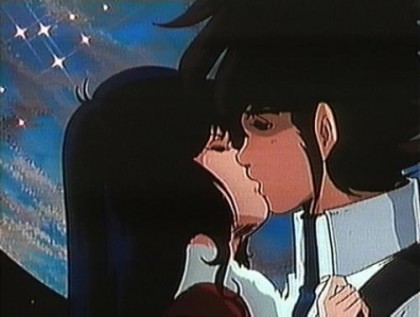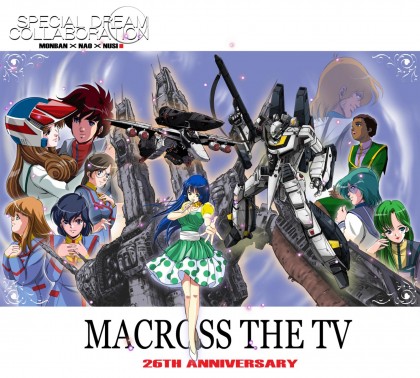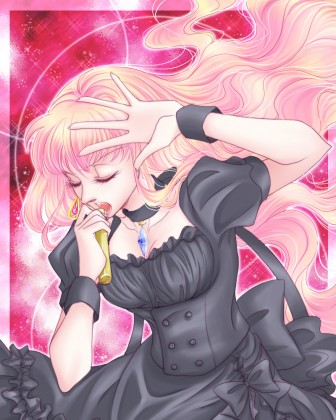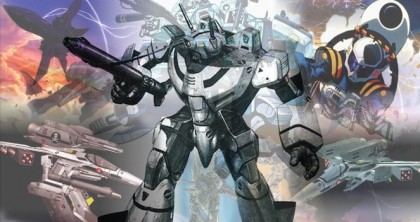Enter Citrus! I know I’m a slowpoke here, but it shouldn’t be too late to mark an important milestone in anime history this month! As of October 3, the Macross franchise is celebrating its 26th anniversary – and in this, my first post as a part of Lyrical Spark, I’d like to share my own thoughts on what makes Macross so special.
The original “Super Dimension Fortress Macross” premiered in October 3, 1982, in Japan – but of course, I wasn’t even alive for that. I introduced myself to series about 5 years ago, expecting “just another mecha series” at best and “a weird Transformers knock-off” at worst – but what I got was something that was definitely different from either of those. SDF Macross, and what I’ve seen of its later sequels and prequels, has some unique elements, and those elements are both the hallmarks of the series and the reason that Macross has been able to grow into one of Japan’s greatest anime franchises.
When it comes to what makes Macross great, I have to start at the music. Music in Macross doesn’t just provide atmosphere or stay in the background – it’s a vital, living part of the action that has a real impact on the plot.
In every Macross, heroic characters face off against overwhelming odds, and it’s the power of music that miraculously gets them through the day. I’m sure I wasn’t the only one who stared in amazement as Zentraedi units froze up at the sound of Lin Minmei’s voice. Who knew that they didn’t know what “music” was? In Macross 7, of course it made sense for Basara to install “sound boosters” on his mech. And more recently, who knew that Ranka’s singing would do THAT to the seemingly-unconquerable Vajra?
Music touches the life of everyone in the Macross universe, something the series makes clear time and time again – whether it’s something as simple as seeing a Minmei billboard in the background or hearing Fire Bomber playing softly on a character’s radio, or as complex as the battle choreography taking the music into account in ways that are best described as “just plain awesome” – watch episode 4 of Macross Frontier for a good example of all of this.
And I’m not even done yet. Landing a singing role in a Macross series can launch a seiyuu’s career. Mari Ijima, the voice of Minmei, enjoyed a great singing career after finishing her role in SDF Macross, and Yoshiki Fukuyama of JAM Project can call his role as Basara in Macross 7 as his claim to fame. And from what I’ve heard of Megumi Nakajima, the voice of Ranka in Macross F, she can expect big things in her future. Meanwhile, I’ve gotten my hands on most of the Macross pop songs that these seiyuu made their names singing over the years, and you should too – Macross songs are fun and catchy, and beg you to sing along when they pop up on your iPod’s shuffle.
But I guess that’s enough about the music for a while. Macross, like any other anime, has to rely at least in part on its characters, and what a cast it has assembled over the years. How about Roy Focker, one of the great “manly” characters of all time? Or the Jenius family, doing their parts as both fantastic pilots and musicians? Who wouldn’t follow Captain Global to hell and back? And what about Basara, the rocker who swore he could end a war with music (and did!) or Sharon Apple, the world’s first digital idol? (Take that, Miku!)
 And don’t get me started on the epic love triangles, which come around with every new Macross and become the number-one cause of fan arguments. I’m sure that the triangle between Hikaru, Misa, and Minmei in SDF Macross was one of the things that made the show a must-watch for so many people, and the contest between Sheryl and Ranka for Alto’s love in Macross F stirred up as many new fans as it did old ones. Simply put, Macross love stories are not to be missed.
And don’t get me started on the epic love triangles, which come around with every new Macross and become the number-one cause of fan arguments. I’m sure that the triangle between Hikaru, Misa, and Minmei in SDF Macross was one of the things that made the show a must-watch for so many people, and the contest between Sheryl and Ranka for Alto’s love in Macross F stirred up as many new fans as it did old ones. Simply put, Macross love stories are not to be missed.
Of course, I haven’t yet mentioned the last thing that makes Macross great – the mecha, in particular the transforming jet known as the Valkyrie. Shoji Kawamori, who recently did work on Eureka Seven, made his name working on the original Valkyrie designs in SDF Macross. It’s the original transforming mech, able to go between a fighter jet mode, a humanoid “Battroid” mode, and a bird-like “GERWALK” mode, and the influence of its popular design can be seen all around the mecha community. The Zeta Gundam? The Tristan from Code Geass? Both of them owe something to Kawamori’s Valkyries.
What’s more, the sight of a Valkyrie raining missiles and transforming rapidly in the middle of a battle is iconic, and nothing like what you’ll see in other mecha series. Valkyries move with speed and grace that you don’t see in other mecha, which makes for visually thrilling action sequences, especially when combined with the CGI graphics seen in Macross Zero and Macross F.
And I can’t forget to mention the Macross-class ships that give the series its name. They’re 100% transformable giant battleships, which really is as awesome as it sounds. Seeing the SDF-1 Macross transform for the first time was one of the highlights of the original series for me.
Honestly, though, the Macross franchise as a whole is a great example of anime at its best, and with Macross Frontier still on everyone’s minds, it’s never been more relevant. If you haven’t seen a Macross series before, I hope I’ve convinced you to give it a try – go pick up a copy of the original series or the “Do You Remember Love?” movie, or just take a look at Macross Frontier. And if you have seen a Macross before, then I hope you had as much fun remembering the best moments as I did while I wrote this. Congratulations to 26 years of Macross – and many more to come!



